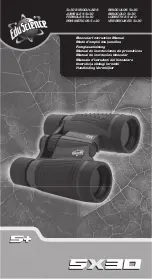
•
Using live ammunition, take 3 or 4 control shots, continually aiming at the same hit point on
the target (you may also use a laser bore sighter and align the laser point to the center of the
cross hairs)
•
Examine the target and determine if the aiming point coincides with point of impact, if you
determine it's necessary to make corrections, you will need to adjust your aiming point. To
move it downwards and to the left, turn the knob (13) counterclockwise, in the directions
Down and Left respectively, the aiming point moves upwards and to the right; keep in mind
that one click of the knob corresponds to a 20mm shift of the hit point at a distance of 100m
•
Check the accuracy of your adjustments by firing another 3 or 4 control shots
•
The scope should now be zeroed-in for the specified distance
TECHNICAL INSPECTION
It is recommended to inspect the riflescope before every use. Make sure to check for the following:
•
Visually inspect the unit is free from any physical damage; cracks, dents or signs of corrosion
disqualify it from proper use
•
Check the sturdiness and proper fit of the mounting system
•
Ensure the condition of the objective lens, eyepiece and the IR illuminator are free of cracks,
grease spots, dirt, water stains and other residue before use
•
Visually inspect the condition of the battery and the battery compartment; the battery should be
free of electrolyte and oxidation residue, especially where the battery makes contact with metal
•
Verify the proper function of the following; selector switch (3), reticle brightness knob (4),
reticle selector button and the instant power-on button (11)
•
Verify the smoothness of the objective lens focusing mechanism (6), diopter focusing knob (7)
and the IR illuminator knob (8)
TECHNICAL MAINTENANCE
Technical maintenance should be done no less than twice a year, and is comprised in the following
steps:
•
Clean the outside metallic and plastic surfaces from dust, dirt and moisture; wipe the scope with
a soft cotton tissue, lightly coating it with gun oil or petroleum jelly
•
Clean the battery compartment's electric contact points using an oil-free solvent
•
Inspect the eyepiece lens, the objective lens and the IR illuminator and gently blow off any dust
and sand, and clean using lens cleaner and a soft cloth; see section entitled “GUIDELINES
FOR OPERATION”
USING THE NVRS 2.5X50 ATTACHMENT
The NVRS 2.5x50 attachment (#29091) increases the magnification power of the 50mm PHANTOM
1.7 times. The attachment screws into the internal groove of the riflescope's objective lens; refer to the
instruction manual for the NVRS 2.5x50 when installing. A possible shift of the aiming point may
occur and, in that case, it is important to sight in the scope as previously described.
USING THE ADDITIONAL WEAVER RAIL
The scope has a built-in additional weaver rail mount (14) housed on the left portion of the body. This
will allow the mount of additional devices, such as:
•
The Yukon IR illuminator, with mount (#29072)
•
The Yukon NVRS directional microphone with adapter (#27022)
•
The Yukon laser sighting device (#27012)



















